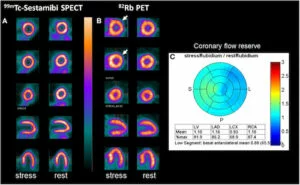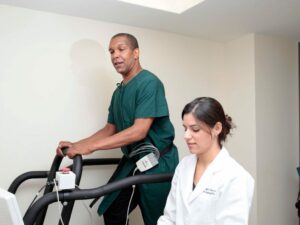 A Nuclear Stress Test is done to measure your blood flow at states of rest, exertion, and medication. Through the test, your doctor is able to tell which areas of your heart have low blood flow.
A Nuclear Stress Test is done to measure your blood flow at states of rest, exertion, and medication. Through the test, your doctor is able to tell which areas of your heart have low blood flow.
Typically, the complete test considers images of your heart when at rest and when under stress by exercise or medication.
It’s one of the tests that could be carried out to diagnose the likelihood of a Sudden Cardiac Death (SCD).
You may be asked not to eat, drink or smoke for a period of time before a nuclear stress test. You will likely also need to avoid caffeine the day before and the day of the test, as caffeine can inappropriately elevate the heart rate for the duration of the test and provide false results.
72 HOURS BEFORE
If you are taking Aggrenox, stop this medicine three days before the exam.
24 HOURS BEFORE YOUR TEST
- NO CAFFEINE
- NO coffee, including decaffeinated or tea/herbal tea of any kind
- NO colas or soft drinks, including those labeled caffeine-free
- NO chocolate (candy, cakes, pies, cocoa, white chocolate, etc.)
- NO Anacin, Excedrin, or other aspirin products containing caffeine
- NO Persantine (Dipyridamole)
- NO Theophylline
- NO beta-blockers (metoprolol/Toprol, carvedilol/Coreg, atenolol, propranolol, labetalol), unless specifically told to continue these medications by your ordering provider or our staff
THE DAY OF YOUR TEST
- DO NOT EAT OR DRINK 4 HOURS BEFORE YOUR TEST. (This includes gum and breath mints.)
- DIABETIC MEDICATIONS should not be taken the morning of your test, but please bring your diabetic medicines with you. If you take
- Lantus (insulin glargine) in the evening, take half your usual dose the evening before the test.
- NO water pills (diuretics) until after your test.
- Bring your medications with you in their original containers.
- Bring a high-fat snack to eat after the stress portion of the exam.
- Bring your insurance cards with you.
Your doctor may opt for a Nuclear Stress Test if you experience symptoms such as shortness of breath and chest pain. Routine stress tests don’t specify the cause of these symptoms.
The test can also be used to help shed a light on the treatment methodology in case you’re diagnosed with a heart condition such as CAD or arrhythmia. It helps them determine how well the treatment is working and set the right treatment path. It also helps determine the amount of exercise your heart can handle comfortably.
Here are more reasons why your doctor may recommend a Nuclear Stress Test:
- To diagnose Coronary Artery Disease (CAD): Coronary arteries are the main blood vessels tasked with supplying blood, nutrients, and oxygen to your heart. When plaque builds up in the coronary arteries, they become damaged or develop diseases. Symptoms such as shortness of breath and chest pains may indicate CAD. A Nuclear Stress Test may be necessary to determine if it really is CAD.
- To see the size and shape of your heart: The images taken during a Nuclear Stress Test can help determine if the size and shape of your heart are normal and measure its ejection fraction (the pumping function of the heart).
One of the main reasons why a Nuclear Stress Test may be necessary is to determine if blood is flowing freely enough through your coronary arteries. It helps identify blockages and damage in your heart blood vessels.
 The Nuclear Stress Test comprises two parts: One in a resting state and another during exercise. In total, the two portions can take anywhere between three and five hours.
The Nuclear Stress Test comprises two parts: One in a resting state and another during exercise. In total, the two portions can take anywhere between three and five hours.
When you arrive, your doctor will ask you about your medical history and your physical activity behavior.
Before the test, a technician will insert an Intravenous Line (IV) into your hand or arm then place patches (electrodes) on your chest, arms and legs. These patches connect to an Electrocardiogram Machine which records your heartbeat triggers. There’s also a cuff on your arm that helps check changes in your blood pressure during the test.
For the resting portion of the test, a radioactive dye is introduced into your bloodstream through the IV and allowed to circulate for a while. Then images of your heart are taken to show the resting blood flow.
Treadmill/Stress Portion of Nuclear Stress Test: For the stress portion, you’ll be placed on a treadmill/stationary bike or––if you can’t exercise adequately––given some medication through the IV. After your heart is stimulated, more radioactive dye is introduced into your bloodstream through the IV. And again, images of your heart muscle are taken using a machine resembling an X-Ray machine.
These two images help the doctor determine the efficiency of your blood to your heart at rest and when under stress.
Depending on the kind of medication administered to you, side effects may be similar to those you’d get from exercising, including shortness of breath and flushing.
If you’re exercising, the test will begin with a slow pace on the treadmill which increases with speed over time. The doctor will advise you not to hang too tightly on the railing as this may skew the results. If you’re put on a stationary bike, resistance will increase as the test progresses.
The stress test continues until your heart rate reaches a set target, but you can ask your doctor to stop the test if you get too uncomfortable to continue.
When the test is complete, you may return to normal activities unless your doctor tells you otherwise. The radioactive material will naturally leave your body in your urine or stool. Make sure to drink plenty of water to help flush the dye out of your system.
While the test involves the patient being exposed to some amount of radiation, the Nuclear Stress Test is generally considered safe. Complications are rare but not ruled out. They include:
- Allergic reactions to the radioactive dye
- Arrhythmias caused by the exertion or medication. It goes away gradually once you stop the exercise or the medication wears off.
- Heart attack. This is extremely rare.
- Chest pains or flushing. These are usually brief, but you should be sure to tell your doctor the moment they occur.
The alternative to a nuclear stress test is an exercise stress test, in which the patient runs on a treadmill with EKG electrodes to determine and monitor cardiac activity.

 A Nuclear Stress Test is done to measure your blood flow at states of rest, exertion, and medication. Through the test, your doctor is able to tell which areas of your heart have low blood flow.
A Nuclear Stress Test is done to measure your blood flow at states of rest, exertion, and medication. Through the test, your doctor is able to tell which areas of your heart have low blood flow. The Nuclear Stress Test comprises two parts: One in a resting state and another during exercise. In total, the two portions can take anywhere between three and five hours.
The Nuclear Stress Test comprises two parts: One in a resting state and another during exercise. In total, the two portions can take anywhere between three and five hours.

